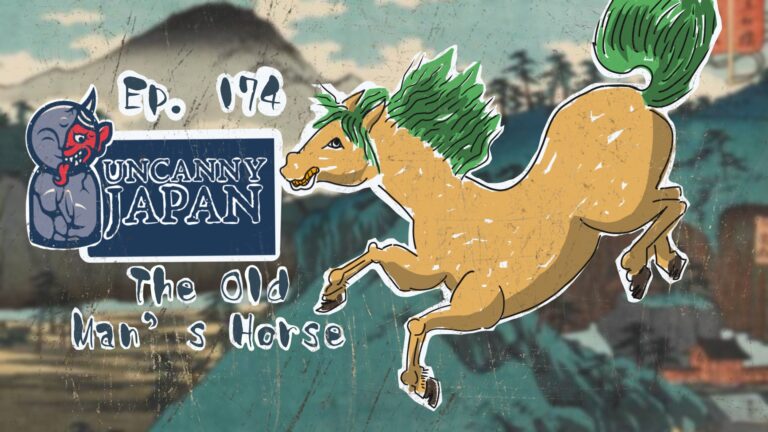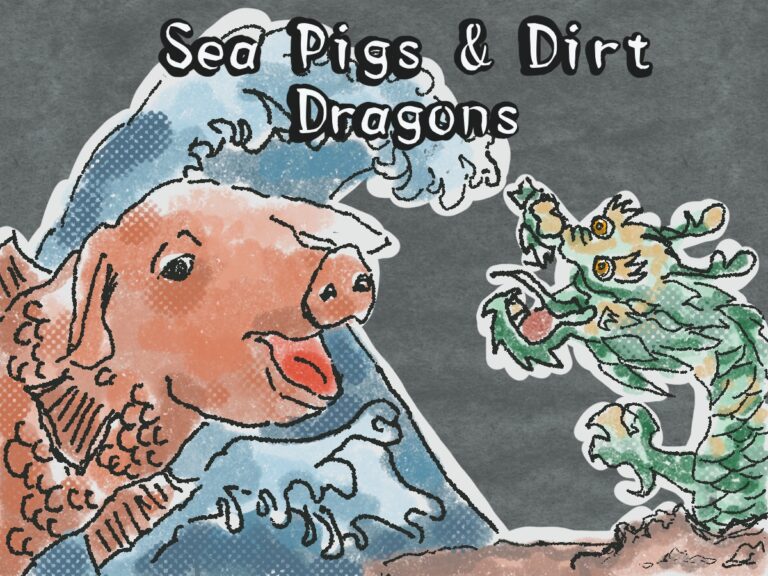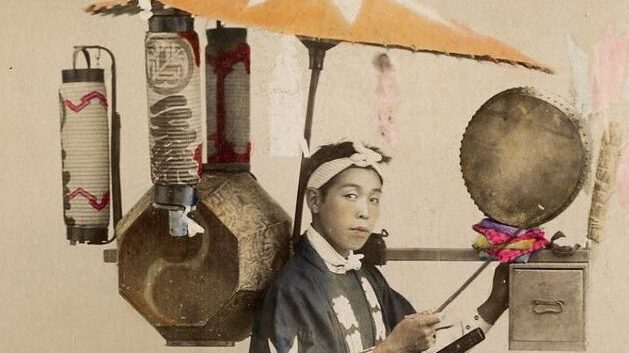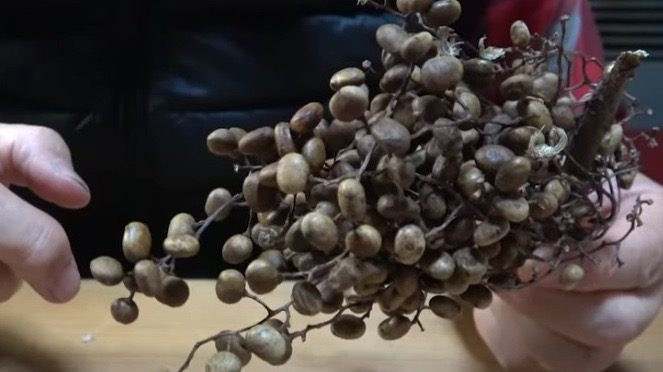Hey hey, I’m Thersa Matsuura and you’re listening to Uncanny Japan.
When you think about summer festivals in Japan what comes to mind?
Gion Matsuri, Kyoto
You might imagine the month-long Gion Matsuri in Kyoto with its elaborate floats in red and gold, giant wheels creaking as they’re pulled through the downtown streets. Flutes and bells and chanting, called kakegoe. Maybe you’ve seen photos of these Yamaboko Junko some up to 25-meters high and decorated with a wall of paper lanterns that at night, tower above the massive crowds, glowing majestically.
Nebuta Matsuri, Aomori
Or there’s the Nebuta Matsuri way up in Aomori Prefecture. You’ve definitely seen pictures or videos of these amazing, (again) enormous floats that carry colorful 3-D depictions of fierce oni and twisting dragons battling legendary heroes. They’re made from washi paper over wire frames and lit from within. What makes them even more unique is that they’re pulled through the streets and spun around dramatically so they can be viewed by everyone from all sides.
Awa Odori, Tokushima
Or could it be you’re thinking of Awa Odori down in Shikoku, Tokushima. Where hundreds upon hundreds of dancers turn out in the streets to do that silly yet utterly cool Awa Odori or Fools Dance. The music is upbeat and non stop, changing slightly depending on the group doing their version of the dance. They crouch low, bend a little forward at the waist, and wave their hands or fans in the air, but it’s that footwork that really makes the dance.
Well, we won’t be talking about any of those today. Think smaller. No, smaller than that. Think your local shrine grounds just down the street.
So what are these quaint summer festivals like in Japan? While I kind of guess they are similar all up and down the country. I’m sure each place has its own unique flavor and interesting differences. Today though I’m going to take you on a visit to the kind I’ve experienced, taken part in, and helped plan and run throughout the years.
This is Part One: Outfits and Eats. Part Two will be: Games and Dancing
Intro
Hey hey, how are you? Big typhoon is afoot, so this episode might be a little late. As I’m recording this, Lan might be sweeping in, might have moved a little south. So depending various nature-related things, this could be right on time, or not. If you hear banging. That’s typhoon wind. So unless you hear my door being blown off. Everything’s fine. Just noisy. Speaking of noisy.
Okay, let’s get to the festivities. I think it’s pretty safe to say you can find summer festivals or natsu matsuri (夏祭り) in every single prefecture, in most if not all cities, all over Japan — not just the big ones like I mentioned in the intro, but also small ones held by preschools, kindergartens, elementary schools, neighborhoods and kodomo-kais — kodomo (子供) meaning child and kai (会) the suffix for association or organization. So a kodomo-kai is a “children’s association”.
Kodomo-kai — Children’s Association
What’s a Children’s Association? Neighborhoods here aren’t quite as distinct as they are back where I come from. They’re divided in districts called chonaikai or jichikai, basically neighborhood associations, and I could do a whole episode on the in and outs of these. But for today just imagine that all the children in each of these chonaikais are asked to join their designated kodomo-kai. This is from an early age, like four or five, and they continue taking part, all the way until they graduate sixth grade when there’s a big party and they’re released, because life is about to get really busy with school, after school studies and club activities.
Anyway, the kodomo-kai is pretty much run by the moms. We plan various events throughout the year to keep the young ones entertained and kind of all connected. Everyone knows everyone else and that’s kind of nice. Well, sometimes not nice, but that’s a human problem there. Overall, it’s lovely to watch all the kids grow up together.
Of course, Julyan and I used to be members and I was one of the planners for quite a few years. We did things like yearly Christmas parties, summer sports events, and a monthly birthday party to celebrate all the children in the group born that month, and, of course, the summer and fall festivals.
If you ever do get the opportunity to live here, I encourage you — if you’re brave — to participate in these kinds of groups. It won’t be easy. There will be language and culture bumps in the road. You’ll no doubt make mistakes — I know all that very well. But it’ll be such a great experience for you and you might just make some good friends. If you don’t have children, though, you can still attend your neighborhood festivals, be them in the summer or fall and that’s fun, too.
Nōryōsai (納涼祭) — Cool Evening Festival
So to start, you’ll often hear summer matsuri called Nōryōsai (納涼祭) which translates as “Cool Evening Festival” or “Summer Night Festival”.
Since the season is in the air, let me take you through my version of a Nōryōsai. Like the name implies, it all happens after the sun goes down and the day cools off a touch. But you usually want to arrive at dusk, that golden hour when the light is soft and orange and you can take the best photos. Because that’s what you’re going to want to do, take a lot of photos. Why?
Because you just spent all afternoon getting gussied up for it. As did your friends. And you’re going to want to get a zillion photos of you, them, other classmates who also look pretty dandy tonight. No, you don’t have to dress up. You can wear shorts and a t-shirt, but it’s so much more fun when you do.
The Yukata (浴衣)
Women and girls of all ages usually wear colorful but more often pastel yukata. Think mint green, lavender, soft pink and sky blue. If you’ve never seen one, imagine a simple garment, somewhat the style of a kimono, but much more casual, not as long. They’re made from cotton and can be printed with images that remind you of summer. Things like dragonflies, morning glories, butterflies, peonies, and goldfish.
It’s always a good idea to carry a flat uchiwa fan, that you can stick in the back of your obi if you don’t want to hold it. But it’s there for easy access. And also don’t forget a small handheld drawstring purse called a kinchaku (巾着) for your money, because there will be fun and delicious things to do and buy.
Shoes can be simple geta, those high wooden open-toed shoes; or zōri sandals, that look like extremely fancy flip flops. Your hair is done up, various ornaments, clips, combs, and pins are all neatly in place. Extra points if these, too, are also summer themed. Flowers with dangling strings of petals is nice. I think we can all agree, Japanese hair ornaments are the absolute best.
Jinbei (甚平)
For those who want to wear the male version, there are yukata in earthy tones, browns, blacks, dark blue, stripped or checked or some old fashioned pattern. But you’ll also see jinbei which is a two-piece cotton outfit. While very little kids can wear jinbei in everything from super cute pinks, reds, and oranges, the older you get they tend to be more natural colors. Traditionally for men and boys, these days, I think it’s totally fine for them to be worn by anyone. I find them much more comfortable than a yukata, which I’ve never owned.
Actually, there’s a photo out there of me when I was at Clarion the week Cory Doctorow was teaching and we came down to the common area to write after dinner, both wearing near identical jinbei. We did that Spiderman meme, pointing at each other for a second or two, then took a photo of us flashing peace signs. Anyway, great loungewear if you’d like. Those are called jinbei (甚平).
And finally for festival clothing, you might see some of the dads and older men or women, too, who are participating in the festival wearing happi coats.
The Grounds — Yagura and Yatai
Now, you’ve made it to the site of the festival, lots of people milling about. The local shrine is set back a ways. But the first thing you notice is in the middle of the open ground is a lit up, elevated platform skirted in a red and white striped cloth. This is called a yagura. It’s center stage even though it’s a little high and not very easy to see what’s going on up there. What you do notice, though, a very large taiko drum. There’s a simple roof, but except for the supports at the four corners, it’s open on all sides, so when the drummer starts playing you’ll be able to see him from wherever you are on the grounds. There’s also a speaker up there and an amp playing old timey-sounding obon music.
What really adds to the atmosphere is that from the roof of the yagura are strung long lines — at least four — of paper lanterns. Glowing and swinging in the breeze, they stretch from the corners of roof of the platform, over everyone’s head, across the grounds, ending at the corners of the park.
But it’s not time for dancing yet — that starts at eight — so you make beeline to the yatai that are set up all along the fences that surround the shrine grounds. Yatai are small mobile food stalls and can be found all over Japan. And they can be anything from a two-wheeled wooden cart selling ramen that is pulled from place to place by its owner to the near permanent ones that line the streets of Fukuoka and are visited by people from all over Japan and the world because of the cool atmosphere and tasty foods.
One things for sure, you’ll almost always find rows of yatai along the perimeter of summer and autumn festivals, or lined up along the sides of streets.
Yatai Foods
Each yatai is simply constructed, square boxy designs from which all manner of delicacy or street food is sold. Along the top is a thick, brightly-colored banner that announces in bold kanji what’s at that particular booth. Jaga bata-/butter-roasted potatoes or wata-ame/cotton candy in cute bags or biiru/beer. As you walk along the venders will be calling out their wares to further entice you.
What makes yatai more fun than just their sweet or savory yummies, is that the table or counter in front of each one not only displays the foods in some attractive fashion to make you want to buy them (like a high pyramid of hotdogs on a stick or rows of bananas — also on sticks — that have been dipped in chocolate or white chocolate dyed pink or light green and sprinkled with rainbow-colored sprinkles.), but also you’ll find the people running the booth actually preparing the foods right in front of you, which is entertaining, too.
You’ll find still warm, entire squid — again, skewered — with their triangle tail making them look like fat little rockets, displayed next to a grill where the cook is drenching them with mirin-sweetened soy sauce and turning them, smoke bellowing as the juices drip off and pop in the coals.
Or on a big flat iron grill and you can watch a sweaty man deftly maneuver two wide metal spatulas as he scrapes and turns a giant heap of yakisoba/fried noodles, tossing in chopped cabbage, pieces of pork, pickled ginger and splashing in some sweet brown sauce on that sizzles and he mixes and flips the quickly crisping noodles again.
So go on now, you haven’t eaten all day and you have a kinchaku or pocket full of coins. Make your way through the crowds or stand in line and buy whatever your heart desires. It’s getting darker now and the whole area is lit by the hundreds of swaying lanterns over head. It might be a little hard to decide what to get first the evening air smells so mouthwatering.
There’s the aroma of soy sauce braised corn roasting and the gingery scent of deep fried chicken pieces, but then there’s also the cakey fragrance of taiyaki, fish-shaped cakes filled with red bean paste, vanilla-custard cream, or chocolate; and let’s not forget the crepes slathered with whipped cream, nuts, chopped strawberries and kiwi fruit, folded over and slid into a paper cone for your ease of eating.
Boat Dishes (船皿)
All of the festival foods are prepared to be easily eaten. Lots of stick foods, the frankfurters, yakitori/chicken pieces, candied apples, corn dogs — called American Dogs, even salted, iced cucumbers come on a stick. Or the food will be served in a small cup or these neat dishes made from shaved pieces of wood called funesara or boat dishes. They’re shaped in such a way, the sides curve up, making them looking like a little boat. They keep heat away from your hands better than plastic (although, these days plastic is used, too). So they’re easy to carry around, the funesara in one hand, chopsticks in the other.
So for an authentic experience it’s nice to have your takoyaki octopus balls or okonomiyaki a savory cabbage, flour, and usually slices of pork dish. Both covered in sauce, mayonaise and katsuobushi/shaved smoked bonito flakes.
Okay, it’s dark now and your pretty full. You have your cup of kakigōri/shaved ice or shave ice which is not a snow cone, like I grew up with — the ice all pebbly and you have to crunch it. Kakigōri is also made right in front of you, by taking a huge square of ice and spinning it, shaving off the most delicate of ice slivers. It’s feather-thin and melts quickly in your mouth. Ichigo milk, strawberry sauce with a nice dousing of condensed milk is the usual summer time go to. Although there is lemon and melon and blue Hawaiian, too.
You can go and stand under the tree over there with your friends, taking in the sights, smells, and sounds. Finish your treat, because after you’re done, it’s time to play a couple games before the dancing and fireworks start.
Thank you and Story up on Patreon
Which will do next time.
Thank you all for listening. Thank you patrons especially for supporting the show and keeping this all going. For those who are patrons maybe newer ones who don’t know, and those who might want to become patrons, I have one of my stories called “Sasa’s Rouged Lips, Sasa’s Reddened Cheeks” that I recorded and put up as a monthly bedtime story. It’s set during the evening of one of these summer festivals and begins with a young oni who is going against her nature, getting dressed up to meet her lover –who is not an oni. There’s forbidden love, there’s fireworks, there’s an awesome fight scene.
So that’s up for all patrons.
Thank you again, and I’ll talk to you in two weeks.
Thank you all for listening. Thank you patrons for keeping me going. I am grateful every single one of you. I’m also planning a wee trip to see Julyan in Hokkaido in the fall, so you can bet I’m going to try to see cool places and post on Patreon for you all. I’m enjoying the weekly Sunday night posts, too.
Talk to you all in two weeks, bye bye~






